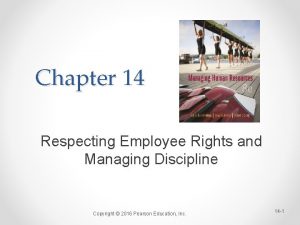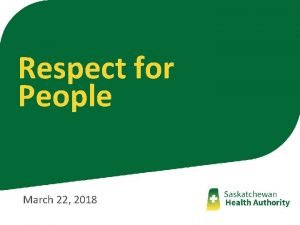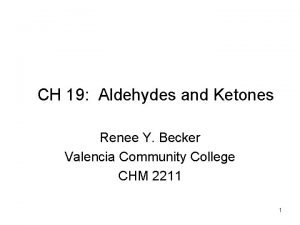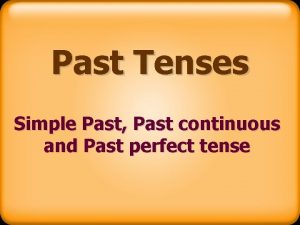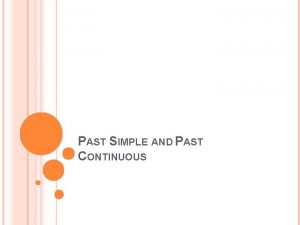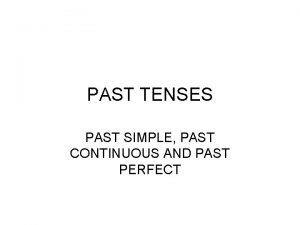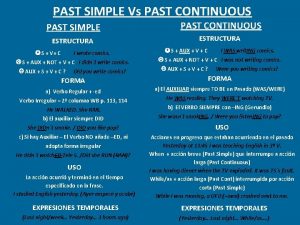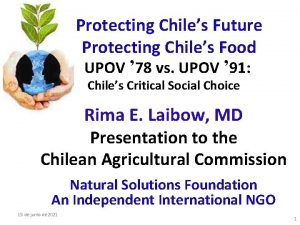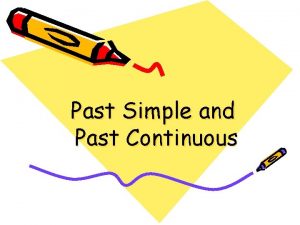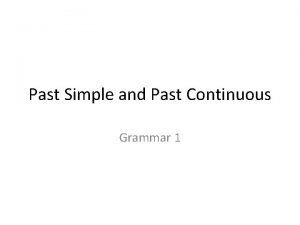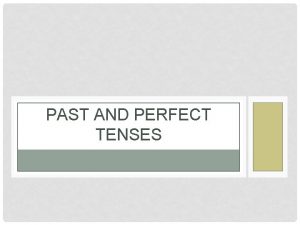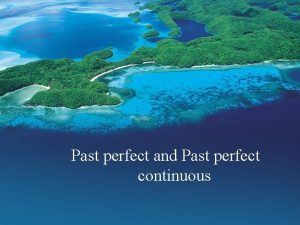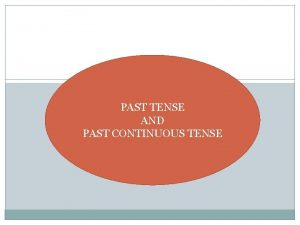Respecting the Past and Protecting the Future Strategies



















- Slides: 19

Respecting the Past and Protecting the Future Strategies for Implementing Digital Best Practices in Historical Archaeology Research on Military Installations Kelsey Noack Myers, Ph. D, RPA LG 2 Environmental Solutions

I would like to take a moment to respectfully acknowledge that this meeting is being held on the ancestral homelands of 34 pueblos and tribes, as well as other traditional and indigenous communities currently lacking federal recognition. I would like to recognize these communities and their continued and sincere relationship with the landscape. Photo credit: Pueblo of Acoma’s Sky City Cultural Center and Haak'u Museum

Federally-recognized tribes with THPOs based in New Mexico: Jicarilla Apache Nation Mescalero Apache Tribe The Navajo Nation* Pueblo of Acoma The Pueblo of Isleta Pueblo of Jemez Pueblo of Laguna Pueblo of Pojoaque Pueblo of San Felipe Pueblo of San Ildefonso Pueblo of Santa Ana Pueblo of Santa Clara Pueblo of Tesuque Pueblo of Zia Zuni Pueblo

For more information about Tribal Historic Preservation Offices based* in New Mexico please go to: http: //www. nathpo. org/thpos/finda-thpo/#nm This page lists the most up-to-date, full contact information for all Tribal Historic Preservation Offices across the country. -Please share with your colleagues*Note: the location of an office does not mean that the associated tribe must only be consulted for cultural resource issues in that state. Reservation lands represent a very small portion of each tribes’ ancestral homelands, which do not equivalate to modern U. S. states. THPOs in many regions are often located in areas far removed from their homelands.

Abstract In Cultural Resources Management, many archaeological survey projects are undertaken through contract services provided to regional federal clients with large-scale resource evaluation needs. In the case of military properties, each installation maintains SOPs and curatorial operations to serve the needs of their unique CRM department. While modern military and government security may exist at the forefront of on-the-ground practice at these locations, the historical research and archaeological data related to historic and precolonial communities and individuals that once resided on these properties should be handled with equal sensitivity. This paper examines practical digital strategies implemented at military installation sites in the southeastern United States to protect the legacy of those who lived in the past as well as those who are working to protect sites for the future, through the processes of resource evaluation, management, and interpretation for the public.

Much of the archaeological research in which I currently participate as a government contractor occurs as performance of compliance-based Phase I and II evaluations for various Department of Defense (DOD) Installations. Primarily these are Army installations, with contracts facilitated by the Army Corps of Engineers for the U. S. Army Installation Management Command (IMCOM).

Government Business Development A complex process, that requires indepth, firsthand experience to be best appreciated, government business and federal contract service provision could easily fill the program for an entire conference on its own. Suffice it to say that government contracting in archaeology relies on the need for federal properties to maintain a cultural resources program to meet Section 106 requirements on Installation, and that several levels of administrative oversight govern every detail from fiscal year budgeting to special project design, from contracting decisions to personnel structuring, and most germane to this presentation: the awarding of contracts to private-sector environmental compliance firms. Source: https: //www. ez 8 a. com/

CRM on DOD installations, as contracted by the Corps*, facilitates fulfillment of regulatory requirements, but neither the IMCOM nor USACE maintains the personnel and resources to perform the work at the same cost and on the same schedule that private sector companies are able to deliver. While this can mean big business for government contractors in environmental compliance services, this work is a very small piece of the pie (fiscally and operationally) for the DOD. Budgets are allocated following organizational structure, which for exampleƗ, at Fort Stewart, GA, includes: • Army • IMCOM • Garrison Command • Directorate of Public Works • Environmental DivisionƗ • Prevention and Compliance Ɨ • Land ManagementƗ • Installation Cultural Resources Ɨ Management … making this work a relatively minor part of the DOD overall mission. *Installations may also utilize General Service Administrations, National Park Service in other Regions, MICC (Main Instrumentation and Controls Contractor), and others to execute contracts. Our mission: IMCOM integrates and delivers base support to enable readiness for a globally-responsive Army. We Are the Army's Home Our vision: Committed to Service Enhancing Readiness Foundation of the Army Culture IMCOM handles the day-to-day operations of U. S. Army installations around the globe – We are the Army's Home. Army installations are communities that provide many of the same types of services expected from any small city. Fire, police, housing, and child-care just some of the things IMCOM does in Army communities every day.

How are private contractors chosen as the best service provider for a USACE contract? Awards of contracts are based on 5 categories of criteria known as Evaluation Factors. These include: • Specialized technical capabilities regarding the services required. • History of previous work of a similar nature. • Qualifications and Experience of key Personnel (and/or Contractors). • Past record of performance on contracts with respect to control of costs, quality of work*, ability to meet schedules, contract administration, and accurate and timely work products that receive favorable reviews* from SHPO and THPO. • Price (https: //www. dau. mil/tools/p/cprg) - However, “All evaluation factors other than price, when combined, are significantly more important than price. ”

Congratulations! You’ve been notified of an intent to award the contract for which you have submitted a proposal. Now you need to: • Finalize your work plan and dedicate all necessary personnel, vehicles, etc. to the project • Be ready for the kickoff meeting with district officials and Installation CRM within 7 days of the award notice • Ensure all personnel are certified to meet DOD requirements for presence on base and level of responsibility and performance (43 CFR § 7. 8 and https: //www. nps. gov/history/local-law/arch_stnds_0. htm) • Follow military safety and security SOPs and operate in accordance (A-T/i. Watch/Op. Sec training, range control check-ins, daily communications, etc. ) while following access scheduling for training areas in priority with other operations • Provide for personnel health & safety on-site through adequate training and supplies (OSHA, UXO, CPR/First Aid etc. ) • Complete equipment maintenance and provide/manage field supplies • Communicate company SOPs and other operational info to field director and crew to ensure contract & PWS requirements met (https: //www. law. cornell. edu/cfr/text/43/7. 8) such as level of effort targets, research questions, evaluation criteria, etc.

All of this however, is a lot of information to keep in the forefront of one’s mind while also overseeing the investigation of the integrity and research potential of historic resources to determine whether or not they meet criteria to be deemed significant* and justifiably worth the resources to monitor, protect, and if possible, further investigate for the indefinite future. *What makes a resource significant when conducting Section 106/NRHP evaluations? According to 36 CFR 800. 4(c)(1), “the agency official shall apply the National Register criteria (36 CFR part 63) to properties identified within the area of potential effects that have not been previously evaluated for National Register eligibility. The passage of time, changing perceptions of significance, or incomplete prior evaluations may require the agency official to reevaluate properties previously determined eligible or ineligible. The agency official shall acknowledge that Indian tribes and Native Hawaiian organizations possess special expertise in assessing the eligibility of historic properties that may possess religious and cultural significance to them. ” And 800. 4(c)(2) “Determine whether a property is eligible. If the agency official determines any of the National Register criteria are met and the SHPO/THPO agrees, the property shall be considered eligible for the National Register for section 106 purposes. If the agency official determines the criteria are not met and the SHPO/THPO agrees, the property shall be considered not eligible. If the agency official and the SHPO/THPO do not agree, or if the Council or the Secretary so request, the agency official shall obtain a determination of eligibility from the Secretary pursuant to 36 CFR part 63. If an Indian tribe or Native Hawaiian organization that attaches religious and cultural significance to a property off tribal lands does not agree, it may ask the Council to request the agency official to obtain a determination of eligibility. ”

Overall objectives for archaeology contractors: 1. Produce quality products (field documentation, NRHP evaluations, management summaries, material culture curation deliverables, digital data package, hard copy final report) meeting exact client requirements, i. e. few corrections required following draft submittal 2. Make a profit (Firm fixed-price format for many subcontracts) • assign adequate staff, equipment, supplies, time to project in proposal to avoid drawing from overhead • maximize resource use within timeframe available based on installation scheduling • meet target deadlines established by negotiated contracts/MOAs/federal guidelines • provide evaluations and curation deliverables package to client in format compatible with existing structures

Responsibility in Compliance Archaeology Yes, in compliance archaeology, we are tasked with making difficult decisions about whether or not to protect a historic resource based on its integrity as determined by a standardized set of criteria that have been designed to apply to all resources that fall under the jurisdiction of NHPA. When we constantly view the past through this lens, it is easy to become removed from the humanity inherent in archaeological research. Especially because none of the guidelines, requirements, or criteria I have discussed in this presentation so far have mentioned the word sensitivity, mentioned taking a holistic view of the cultural past, or stated that any researcher or report product is required to frame evaluation from a subjective perspective of respecting past populations as once-living individuals with families, problems, needs, and histories of their own. …or have they?

Is it possible to do ETHICAL and PROFITABLE compliance-based archaeology? Remember the proposal evaluation criteria I mentioned previously? Criteria IV: “Past record of performance on contracts with respect to control of costs, quality of work*, ability to meet schedules, contract administration, and accurate and timely work products that receive favorable reviews* from SHPO and THPO. ” *This implies that the quality of work not only be measured by completeness of write-ups of the evaluation findings, levels documented, cubic meters excavated, soils identified, and N count of artifacts assembled, but also that the work is a quality interpretation of the general patterns of human behavior that were staged on the evaluated site(s), through time and across the Installation and region.

Where are the opportunities to be ethical and profitable with our data management? Historical research Field survey Include all available documentary evidence/metadata for historic properties, even when sources may conflict Minority and disenfranchised groups may be more Save time and facilitate better coordination between field and lab with born-digital data. obscured in the documentary record; do not Analysis can begin on some data before fieldwork dismiss these individuals as less important, has been completed if need for physical transfer, Provide cleaned and standardized data sets to uninteresting, or unhelpful to your research and transcription, and digitization is eliminated. clients matching their preferred structures and leave them out of the overall site interpretation formats (Open. Refine is a great tool for final QA); Consistency and accuracy can be more easily Write all individuals’ histories with personal make sure your data is both usable and resuable monitored with digital data submission to the home respect; avoid judgmental descriptions of site use, office, and sensitive site information more easily Frame your work within the larger scope of existing economic status, etc. redacted for transfer if needed. data and what role events occurring at your site(s) When utilizing genealogical information from online might have played in the larger community, region, Do not use UTMs for all field documentation – sources, ask permission of connected descendants and sociopolitical structures of the past utilizing arbitrary coordinates in field notes and to discuss very personal details or use uploaded reporting can help maintain sensitivity in products Protect clients’ products by limiting online file photos in the future without redactions being required. transfer outside of direct connections to Installation CRM and administrative personnel (remove all Do not transfer sensitive digital data through working files from any cloud-based/portable file unsecured connections (non-secure cloud storage); this also maintains version control and platforms, emails, social media, etc, ) makes future reference/revision more efficient Deliverables

Where additional opportunities to be ethical (and profitable by creating future opportunities to receive work) in reporting this data? Maintain Represent Don’t forget • Maintain an open line of communication with USACE Officers/Installation Cultural Resources and any other appropriate partners while conducting back ground research, field survey, and writeup - good work starts with good relationships and community relations and these individuals are resources with a wealth of institutional knowledge • Represent the results of your work well, so that it can be reused and modeled by future contractors, employees, and outside researchers (yes, one day someone will see your data and your gray literature!)

How can we best represent our work to the public? (Adding value to our products and being ethical about discussing past populations. ) In some cases, contract services may include an outreach effort through the production of public education materials. For example: Public use of the installation for recreational purposes, as well as historical interest groups (such as the Fort Stewart Historic Communities and Cemeteries Council) creates an opportunity for public interpretation. Deliverables include brochures produced to deliver relevant, accessible, and non-sensitive archaeological and historical research results to the general public. Lorem ipsum dolor sit amet, consectetur adipiscing elite. Sed consectetur risus id justo fringilla, ac commodo mi elementum. In quis elit rutrum ex euismod convallis a in lectus. Cras porttitor leo ut semper accumsan. In molestie purus nisi, in tristique elit mattis eu. Aenean orci metus, feugiat a ipsum finibus, rhoncus rutrum lacus. Fusce finibus quam ac orci eleifend, porta faucibus lorem consequat. Vestibulum egestas faucibus blandit. Aliquam vel lorem non orci lacinia rhoncus eu ut sapien. Donec augue nibh, euismod non mauris quis, aliquet sodales tellus.

Takeaway points ALL ARCHAEOLOGISTS, ESPECIALLY THOSE CREATING AND WORKING WITH GOVERNMENT DATA, SHOULD REMEMBER TO IMMERSE THEMSELVES IN AN INTERPRETIVE MINDSET OF RESPECT AND EMPATHY FOR PEOPLE IN THE PAST. REMEMBER TO NOT TALK ABOUT PEOPLE OF THE PAST IN YOUR REPORTS IN A WAY THAT YOU WOULD NOT APPRECIATE YOUR ANCESTORS BEING DISCUSSED, OR IN WAYS THAT CONTINUE TO REPRODUCE CULTURAL FRAMEWORKS OF COLONIALISM, MARGINALIZATION, OR OPPRESSION. WITH THIS IN MIND, WE CAN STILL MAINTAIN THE SECURITY OF SENSITIVE DATA COLLECTED FROM IMPORTANT MILITARY TRAINING AREAS AND CONCURRENT MILITARY OPERATIONS, WHILE ALSO BEING SENSITIVE TO ITS REPRESENTATION TO AND RECEPTION BY STAKEHOLDERS, DESCENDANT GROUPS, AND THE GENERAL PUBLIC.

Thank You I would like to acknowledge the ancestral and contemporary indigenous groups of the Southeastern U. S. , and all other historic and modern descendant populations of the Fort Stewart & Hunter Army Airfield area for their role in my work, and recognize the significance of their lives in creation of the archaeological record. Thanks also goes to Brian Greer of FSCRM, for his valuable input. Dr. Kelsey Noack Myers, RPA Laboratory Director & Principal Investigator Registered Professional Archaeologist, certification number: 989799 LG 2 Environmental Solutions, Inc. 10475 Fortune Parkway, Suite 201 Jacksonville, Florida 32256 kmyers@lg 2 es. com Office: (904) 363 -1686 ext. 106
 Chapter 6 lesson 2 respecting yourself and others
Chapter 6 lesson 2 respecting yourself and others Respecting employee rights and managing discipline
Respecting employee rights and managing discipline Objectives of respecting others
Objectives of respecting others Objectives of respecting others
Objectives of respecting others Respect objectives
Respect objectives The future continuous and future perfect
The future continuous and future perfect Future perfect continuous and simple
Future perfect continuous and simple Obtaining and protecting your credit vocabulary check
Obtaining and protecting your credit vocabulary check Chapter 9 obtaining and protecting your credit
Chapter 9 obtaining and protecting your credit Chapter 9 obtaining and protecting your credit
Chapter 9 obtaining and protecting your credit Protecting consumers savers and investors examples
Protecting consumers savers and investors examples When+simple past+past perfect
When+simple past+past perfect Past perfect continuous vs past continuous
Past perfect continuous vs past continuous Chapter 20 civil liberties protecting individual rights
Chapter 20 civil liberties protecting individual rights Aldehyde protecting group
Aldehyde protecting group Primary aldehyde
Primary aldehyde Carbamate protecting group
Carbamate protecting group John procotr quotes
John procotr quotes Protecting student data
Protecting student data Biodiversity tends to decrease nearer the equator.
Biodiversity tends to decrease nearer the equator.

